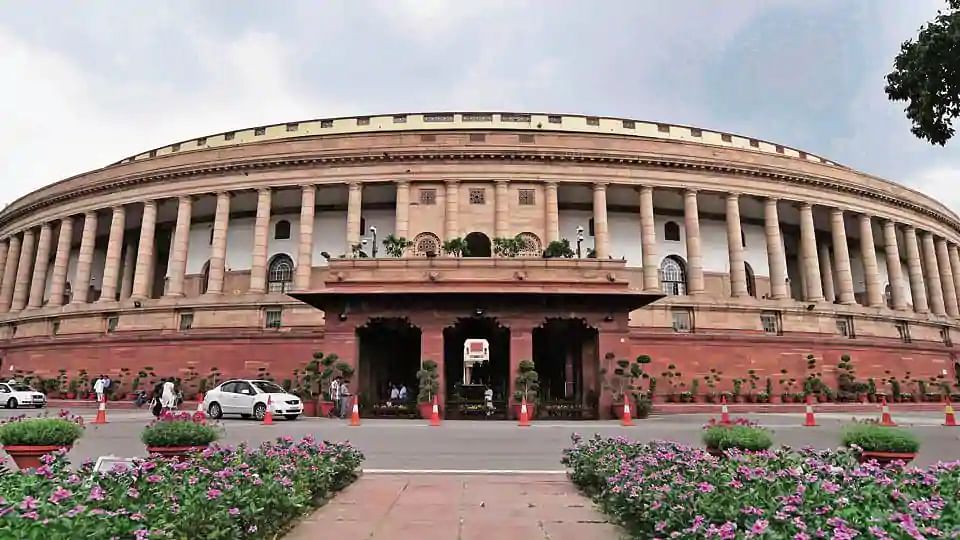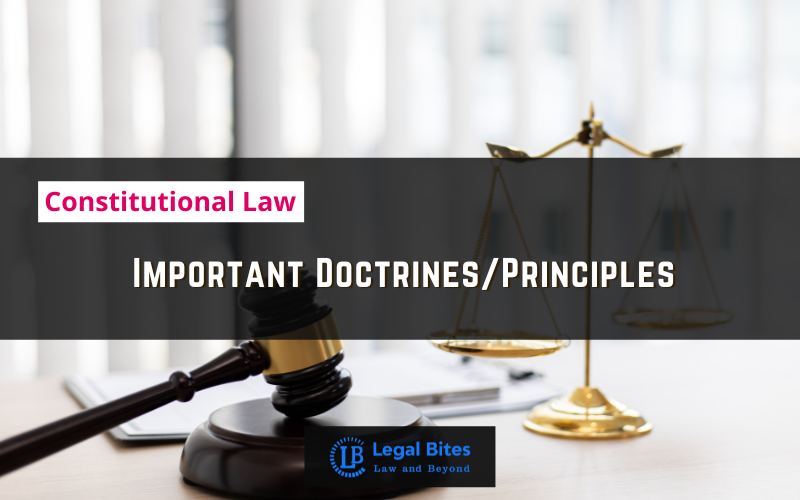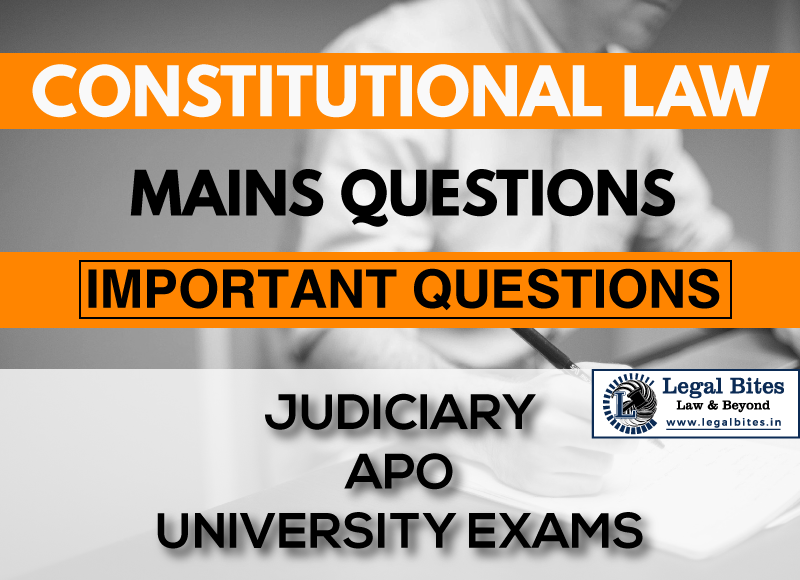Article 13 and Power of Amendment under Article 368
Article 13 and Power of Amendment under Article 368 | Overview Introduction Shankari Prasad Singh Sajjan Singh Case Golaknath Case Kesavananda Bharti Case Raj Narain Case Minerva Mills Case Remark Introduction This article titled ‘Article 13 and Power of Amendment under Article 368’ deals with the Questions which have been raised since 1951, about the constitutional validity of… Read More »
;
Article 13 and Power of Amendment under Article 368 | Overview Introduction Shankari Prasad Singh Sajjan Singh Case Golaknath Case Kesavananda Bharti Case Raj Narain Case Minerva Mills Case Remark Introduction This article titled ‘Article 13 and Power of Amendment under Article 368’ deals with the Questions which have been raised since 1951, about the constitutional validity of the amending procedure mentioned under Article 368. Whether the term ‘law’ under Article 13 of...
Article 13 and Power of Amendment under Article 368 | Overview
- Introduction
- Shankari Prasad Singh
- Sajjan Singh Case
- Golaknath Case
- Kesavananda Bharti Case
- Raj Narain Case
- Minerva Mills Case
- Remark
Introduction
This article titled ‘Article 13 and Power of Amendment under Article 368’ deals with the Questions which have been raised since 1951, about the constitutional validity of the amending procedure mentioned under Article 368.
- Whether the term ‘law’ under Article 13 of the Constitution includes the constitutional amendments?
- Whether the Fundamental Rights were amendable so as to dilute or take away any Fundamental Right through a constitutional amendment?
The worst affected Fundamental Right which has been amended several times is the right to the property contained under Article 31. The basic trend of these amendments has been to immunize, to some extent, state interference with property rights from challenge under Arts. 14, 19 and 31 as well as seek to exclude the question of compensation for acquisition or requisitioning of property by the state from judicial purview.
These amendments have been challenged several times before the Supreme Courts for their constitutional validity.
Important Decisions and Amendability of the Constitution under Article 368
1. Shankari Prasad Singh
In Shankari Prasad Singh v. Union of India[1], which is the first case on amendability of the Constitution, the validity of the First Amendment Act, 1951, limiting the right to property guaranteed by Article 31 was challenged. It was argued that Article 13 prohibits the enactment of law infringing or abrogating the Fundamental Rights i.e. the word ‘law’ include every law even a law amending Constitution and therefore, the validity of such a law shall be judged and scrutinise keeping the reference to Fundamental Rights.
This posed a conflict between Article 13 and 368. The Supreme Court has adopted a literal interpretation rule and thereby held that the First Amendment Act is constitutionally valid. The Court rejected the contention and limited the scope of Article 13 by ruling that the word ‘law’ would not include within its scope a constitution amending law passed under Art. 368. The court stated that:
“We are of the opinion that in the context of Art. 13 law must be taken to mean rules and regulations made in the exercise of ordinary legislative power and not amendments to the Constitution made in the exercise of constituent power with the result that Art. 13(2) do not affect amendments made under Art. 368.”
2. Sajjan Singh Case
For the next 13 years following Shankari Prasad, the question of amendability of the Fundamental Rights remained dormant.
The same question was raised before the court in 1964 in the Sajjan Singh v. State of Rajasthan,[2] where the validity of the Seventeenth Amendment Act, 1964 was challenged. This amendment adversely affected the right to property, placing few rights in the Ninth Schedule and was thus immunized from court review.
The conclusion of the Supreme Court in Shankari Prasad case was reiterated by the majority with regards to the relationship between Article 13 and Article 368 of the Constitution. The court smoothly held that the power given to Parliament by virtue of Art. 368 can be exercised over each provision of the Indian Constitution. The majority in five judges’ bench with 3:2 ratio refused to accept the argument that Fundamental Rights were “eternal, inviolate, and beyond the reach of Art. 368.”
3. Golaknath Case
Overruling the position adopted by the Court in Shankari Prasad and Sajjan Singh, that court now held that the Fundamental Rights were non-amendable through the constitutional amending procedure set out in Art. 368. It was ruled that the term ‘law’ in a comprehensive sense would include constitutional law as well as Art. 13(2) give an inclusive definition of ‘law’ which would take even constitutional law.
Propositions which can be drawn from the majority opinion in Golaknath:
- The substantive power to amend is not to be found in Art. 368, this Article only contains the procedure to amend the Constitution;
- A law made under Art.368 would be subject to Article 13(2) like any other law;
- The word ‘amend’ envisaged only minor modifications in the existing provisions but not any major alteration therein;
- To amend the Fundamental Rights, a Constituent Assembly ought to be convened by Parliament.
4. Kesavananda Bharti Case
The constitutional validity of both Twenty-Forth and Twenty-Fifth Amendments were challenged in the Supreme Court through an Art. 32 writ-petition in Kesavananda Bharti v. State of Kerela,[3] by Swami Kesavananda Bharti, a mutt chief of Kerala. This matter was taken before the bench of the highest number of Judges i.e 13 because, in the case of Golaknath, a decision was made by a bench of 11 Judges which was under review.
Opinions were delivered by the Judges on April 24, 1973, on the wide-ranging arguments which were advanced before the court for over 60 days:
- In Golaknath case, Article 368 was considered to be a provision which provides ‘process to amend’ and not ‘power to amend’. The court held in this classic case that the power to amend the Constitution is to be found in Art. 368 itself.
- The court also recognised that there is a distinction between ordinary law and constitutional law.
- The amending power was now subjected to one significant qualification, that the power of amending cannot be put into effect in a manner that destroys or weaken the basic, essential or fundamental features of the Constitution. This developed the doctrine of basic structure where the constitutional amendment which offends the basic structure of the Constitution is ultra vires.
- Some feature which was regarded by the court as fundamental and, thus non-amendable are:[4]
- Supremacy of the Constitution;
- Republican and democratic form of government;
- Secular character of the Constitution;
- Separation of Powers;
- Federal character of the Constitution.
Therefore, this means that while the Parliament can amend any constitutional provision by virtue of Art. 368, but this power has limitation and is not absolute. The courts have the power to call into the question of whether the amendment is against the principle of the basic structure or destroys any fundamental feature of the Constitution. If an amendment does so, it will be constitutionally invalid.
What is a fundamental feature of the Constitution is a moot point. There is no list which is final and exhaustive of such features. It is for the courts to decide as and when the particular amendment affects the ‘basic’ or ‘fundamental’ feature of Constitution.
The question that was left unanswered in Golaknath case, namely, can Parliament under Art. 368, re-write the entire Constitution and introduce a new Constitution? The answer is that the Parliament can only do that which does not modify the basic features of the Constitution and not go beyond that.
5. Raj Narain Case
The next case in which the Supreme Court had occasion to apply the Kesavananda ruling regarding the non-amendability of the basic features of the Constitution was Indira Nehru Gandhi v. Raj Narain.[5] Here was involved the question of the validity of Clause 4 of Article 329A of the Thirty-ninth Amendment Act 1975. This amendment sought to do three things:
- to withdraw the election of Prime Minister and few other Union officials from the scope of the ordinary judicial process;
- to void the High Court decision declaring Indira Gandhi’s election to the Lok Sabha as void;
- to exclude the Supreme Court’s jurisdiction to hear any appeal.
Clause 4 of the amendment was challenged as destroying the basic feature of the Constitution insofar as it constituted a gross interference with judicial process.
The Supreme Court upheld the contention and declared that Clause 4 as unconstitutional. It violated essential features of Constitution like democratic feature[6] as democracy can only function when and where there are free and fair elections; violated the principle of separation of powers[7] as there is no rational reason for creating a privileged regime for the election of the Prime Minister.
Another significant point which emerged, in this case, was that the principle of ‘basic feature’ was applicable only to a constitutional amendment and not to ordinary legislation. As Justice Chandrachud, explained, the amending power and the ordinary law-making power “operate in different fields and are, therefore, subject to different limitations”.
Therefore with all of this Indira Gandhi was freed from all the charges for corruption on her and also the judgment validated her election as well for Prime Minister.
It is very important to note down the after-effects of the judgment as it leads to quick passage of an Amendment which is also known as the Mini Constitution i.e. 42ND Amendment Act, 1976. It was made as the government desired to ensure that never in the future, the courts have the power to pronounce a constitutional amendment invalid. But this amendment was again struck down in the case of Minerva Mills.
6. Minerva Mills Case
In Minerva Mills Ltd. v. Union of India,[8]the scope and the extent of the basic structure doctrine was considered again by Supreme Court. Section 55 of the 42nd Amendment was inserted which deprive the courts of their power to question any constitutional Amendment.
The Court held that S. 55 is beyond the amending power of the Parliament and void since it sought to remove all limitations on the power of Parliament to amend the Constitution which also conferred such power on Parliament that could destroy or damage the constitution by obstructing its basic or essential features. The true object of these clauses of the 42nd Amendment was to remove the limitation imposed on Parliament’s power to amend the Constitution through the Kesavananda case.
There is no hesitation in saying that the limited amending power one of the basic features of the Constitution. Therefore, Parliament cannot expand its amending power under Art. 368 in order to acquire for itself right to abrogate and do away with basic features of the Constitution.
Remark
Therefore, with the help of the aforesaid cases, we can arrive at the answers of the question mentioned on the top that the term ‘law’ under Article 13 does not include the constitutional amendments and hence, the fundamental rights can be amended through the constitutional amendment but without destroying the basic structure of the Constitution.
[1] AIR 1951 SC 458
[2] AIR 1965 SC 845
[3] AIR 1973 SC 1461
[4] Jain MP, Indian Constitutional Law, P. 1678
[5] AIR 1975 SC 2299
[6] According to Justice Mathew.
[7] According to Justice Chandrachud.
[8] AIR 1980 SC 1789




